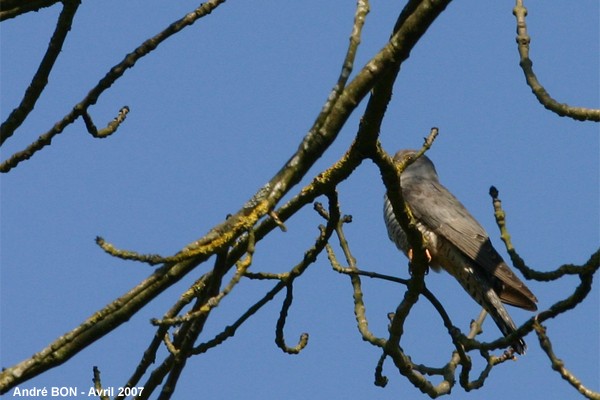

| Common Cuckoo (Cuculus canorus (Linnaeus, 1758)) |


|
|
Scientific name: Cuculus canorus (Linnaeus, 1758) Common name: Common Cuckoo French name: Coucou gris Order: Cuculiformes Family: Cuculidae Size: Body size : 32 to 35 cm; Wingspan : 55 to 65 cm; Weight : 100 to 130 g Habitat: Woodland edges, clearings, cultivated areas with bushes and trees, marshes with reed beds. Food: The Common Cuckoo mainly feeds on insects and larvae. It particularly eats hairy caterpillars which are ignored by other birds. Nesting: The Common Cuckoo is a brood parasite for some small passerine species, mainly the Reed Warbler, the Dunnock, the Meadow Pipit and the White Wagtail. One female can lay 8 to 25 eggs. The Cuckoo chick evicts other eggs or chicks from the nest. The small passerine will feed it and it will start its migration about two month after its parents. Migration: It migrates in winter, over the Sahara, to Equatorial Africa or South Africa. Geographic area: Europe, Asia east to Japan. |
The male's plumage is a grey colour on the upper side. The underside is white with thin black stripes. The tail is a very dark grey colour with white marks. Females are similar to males but can be brown on the upper side. The wings are thin and pointed. The legs are short. |
| [To know more about the Common Cuckoo] [Next picture] [Top] |

|
I was walking in a clearing when, with a nice flight, a bird of prey came and landed not very far from me. I had just enough time to shoot two pictures and it flew away into the forest. That is just after having looked at the pictures that I realized that this was not a bird of prey but the Common Cuckoo. |
| [To know more about the Common Cuckoo] [Previous picture] [Top] |

|
You can see one eye on the previous picture. I have kept this one because you can see the bill. I hope that, one day, I will be able to shoot a picture of a Common Cuckoo where you can see both the eye and the bill. |